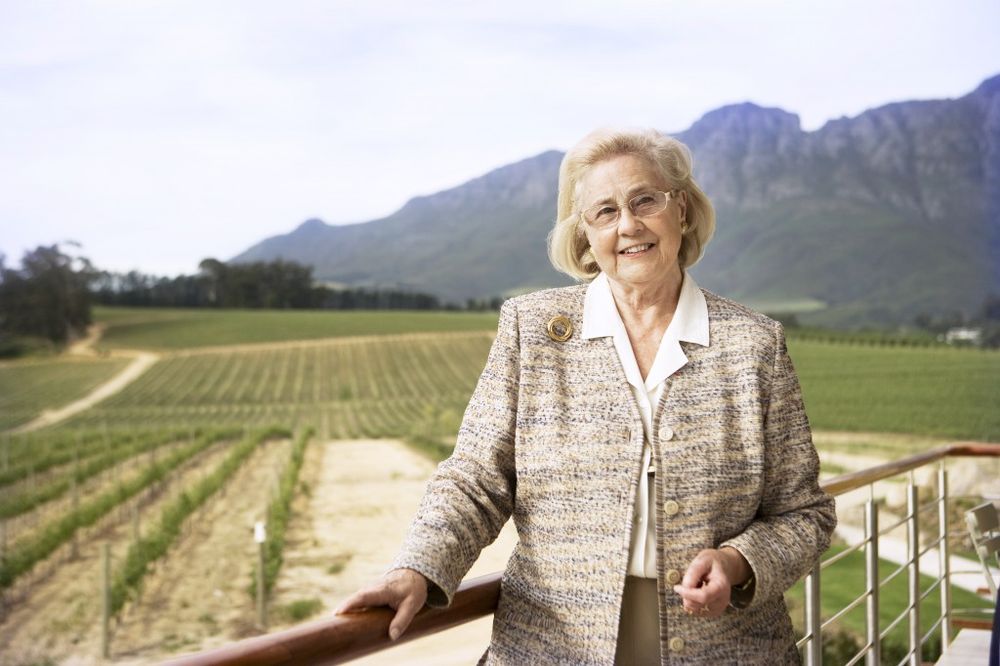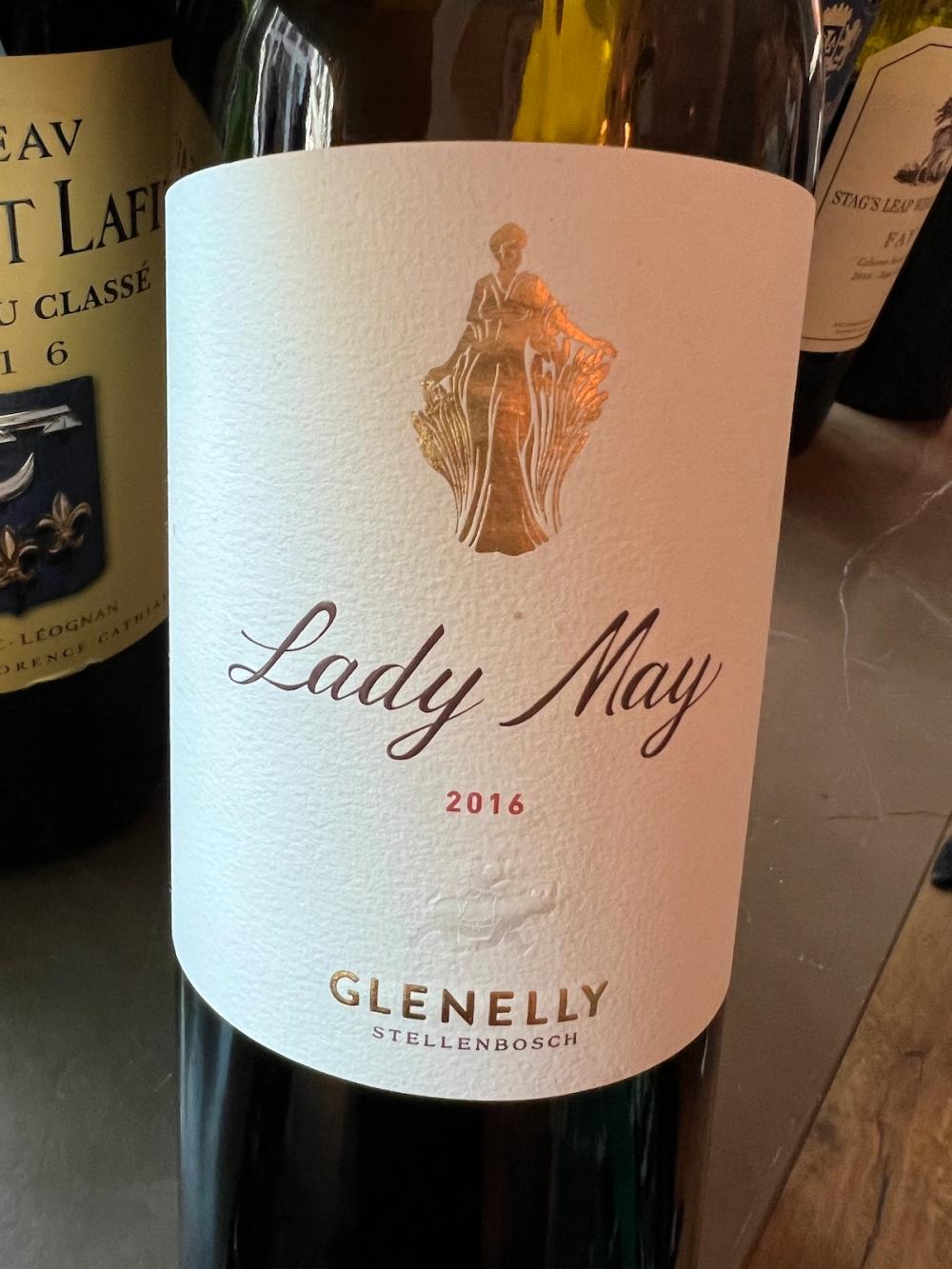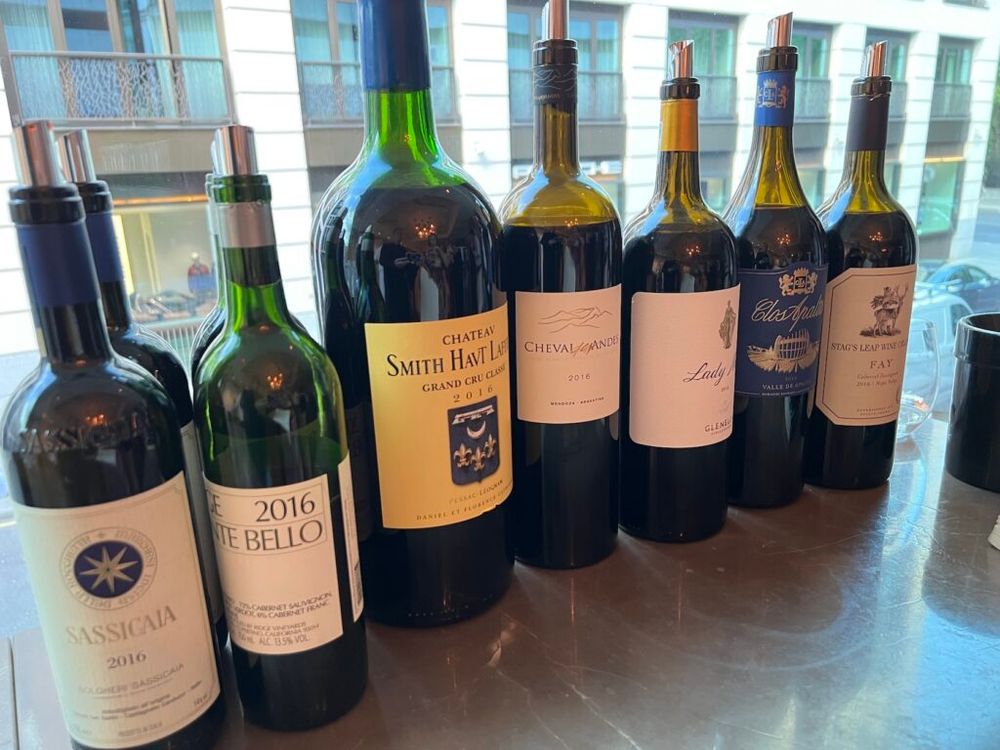There were two tastings held last week in London of Lady May – both involving eight vintages. Roger Jones attended a masterclass where the wines were show chronologically, Peter Dean attended the Hide event where vintages were paired with food, out of synch, alongside other iconic wines from the 2016 vintage.
Lady May, the flagship wine from the Glenelly Estate in Simonsberg, Stellenbosch, is a South African wine with a French touch in that it pays tribute to the legendary Bordelais owner May de Lencquesaing who, at 97, is still keenly involved.

May de Lencquesaing
Lady May as she is called, has had a long and illustrious life, right back to her teenage years when she risked her life during the Nazi occupation in France where she would smuggle food right past the German soldiers to feed the Jewish refugees hiding at Château Palmer (her father had a partnership in the château). She married a French Army general and was stationed in America, but came back in 1978 to take over Château Pichon Longueville Comtesse de Lalande from her late father. Here for 30 years she not only learnt the art of wine making but transformed the estate onto a different level.
She sponsored the IWSC for the Best Blended Red Wine award in the 1990s, The Chateau Pichon Lalande Trophy, again breaking the rules and barriers, and this was won by no fewer than four South African estates in the early days – Meerlust, Vergelegen, Kaapzicht and Kanonkop. Through these introductions she started visiting South Africa and in 2003 bought Glenelly.
May was confident that this property had the potential to produce world-class wines. “The complexity of the soils and subsoils combined with a Mediterranean climate, and planted with our beloved Bordeaux varietals would certainly be a recipe for greatness,” she said.
In 2007 Lady May sold her château in Bordeaux, with the first vintage of Lady May released a year later in 2008, the year winemaker Luke O’Cuinneagain joined the estate. Luke had experience of working in Napa with Screaming Eagle and in Bordeaux at both Château de Fieuzal and Château Angelus, and then spent five years at Rustenberg before joining Glenelly.
The estate is 45 minutes east of Cape Town, at the foot of Simonsberg Mountain, with 123 hectares of land of which half is under vines and the rest is set aside for biodiversity.

Luke O’Cuinneagain, Hide, London, June 15, 2022
O’Cuinneagain on making Lady May
O’Cuinneagain explained the logistics and the knowhow behind making Lady May.
The four classic Bordeaux grape varieties have been used since the first vintage, with their inclusion and percentages varying upon how the vineyard blocks perform in each vintage. For the Cabernet Sauvignon they use C46 clone which is a local clone that produces structured and textured wines, “It reveals itself late on and is broody when young,” O’Cuinneagain says. They also planted 191B which is a French clone that produces softer and rounder wines and gives good fruit expression. “When it’s warmer the C46 clone shines, when it’s cooler the French clone shines,” he adds.
Merlot comes in and out of the blend. Glenelly uses clone 348 which is a French clone high in polyphenols. “It used to be very tannic/ massive and have a bigger extract than the Cabernet Sauvignon,” he says, “so we made some changes, we stopped pumping over so early.”
He also noted that Merlot suffers from heat stress, it shuts down and then you get that green leaf character, so he now plants more on clay soils for protection.
Cabernet Franc is increasingly used in the blend and ranges from 4-13% of the blend. It was introduced in 2012, although it should have been two years earlier but high winds devastated the newly-strung vines. Like the Cabernet Sauvignon it is planted at 270m and is grown on low-bearing vines achieving 4-5 tonnes per hectare. Petit Verdot is also used and brings texture and aromatics to the final blend.
The vineyards are East and South-East facing which means that the fruit has the benefit of the more gentle morning sun for drying out the bunching zones very early on in the day. The slopes are 18-30% which, along with the high diurnal range, preserves freshness in the fruit.
Wind also plays a vital role, O’Cuinneagain says, the estate is 20k from False Bay, so there is plenty of sea wind coming up the valley, giving a cooling effect for the vineyard which takes away the humidity to keep the fruit healthy – but it is also important that the wind is not too aggressive otherwise the vines will shut down.
O’Cuinneagain explains that there are three main winds at Glenelly – synoptic wind created by the difference in high and low pressure, sea breezes “which we can set our watches by” which dry out the canopies, and up-slope/ down-slope breezes.
Production from the vines is low, but good density. Freshness comes from the high diurnal range. O’Cuinneagain uses natural yeasts with minimum intervention, and careful use of oak, using coopers such as Taransaud, Boules and F Freres. Individual blocks are kept separate during vinification, prior to blending.
So how were the Lady May wines tasting?

Wines getting prepped at the Hide tasting
Luke O’Cuinneagain’s notes in italics.
Lady May, Glenelly 2010
“Wind and more wind did damage prior to the shoots, roller coaster vintage, warm dry December, low yielding, taken a while to settle, from ugly duckling to a swan”
Delicate refined perfumed nose, bilberries, dry tannin, with tobacco leaf, fresh acidity and focus, only the third time to produce fruit, cocoa and spice, elegance at end with a savoury feel, gentle spices, still seems young, level and balanced, tobacco and cocoa on finish, quite beautiful, seek it out.
Lady May Glenelly 2011
“Wine to age, cold wet winter, warm ripening season, tight character and structure, needs time to reveal itself”
Taught but textured, layered, green pepper, red and blue berries, vanilla spice, fresh gripping acidity, clean and focused, lovely depth and intensity, ripe luscious berries, still has plenty of time to go, dark berries, with a dark hue to the wine. Still some grip.
Lady May Glenelly 2012
“A rich and robust vintage, characterised by the large temperature spike during the ripening season putting the vines under stress’”
Bright fresh blueberries, crimson, fresh acidity, racy, hints of cassis and cocoa, herbaceous, bilberries and youthful, Cocoa and coffee aromas and perfume, plummy and silky feel, opulent and evolving well. Layered and textured with a beautiful perfume element.
Lady May Glenelly 2013
Complexed and balanced, needed careful picking and timing. Issue was that the earlier varieties ripened later and the late varieties ripened earlier due to late December heat and high soil moisture”
Juicy, meat-driven, bloody juices, spiced, dried herbs, spices, blueberries, cassis, rhubarb, dark raspberries and again spices tingling on the palate. Lots of intensity from clusters of berries, bright intensity combining on palate, powerful but elegant and there is a lovely balance on the end palate leaving a beautiful spiced mouthfeel.
Lady May Glenelly 2014
Rich, round and mellow, all about patience. Wettest vintage in years with rain in November and January, and a cool February. Disease pressure was high so strict control needed, but hang time was long”
First to be an instant hit on the palate, bright rich and powerful with great intensity of blue fruit, restrained tobacco leaf, spices, cocoa and creamy spices on mid-palate, succulent and fresh, bilberries, redcurrants, figs, chocolate buttons, savoury herbaceous bay leaf on middle palate with meat juices and cedar aromatics. The mouthfeel lingers an age fulfilling a gorgeous fruit and umami balance.
Lady May Glenelly 2015
“Superlative vintage characterised by large diurnal changes which created the opportunity for wines with naturally low pH and good acidity levels”
This is the first to give that Bordeaux classic feel and taste, seems more aged, pure precise berries, lovely ripeness, purity and precision but has that maturity of a classy Bordeaux. Delicate acidity that balances the mid palate. Roast lamb juices, hints of farmyard, pretty perfect. Some black fruits coming into play. Definitely some seashell breeze freshness on the opening nose. Great density and texture, combined with the freshness makes this not only a perfect food wine but an exceptional wine that drinks well now but will, of course, age beautifully and gracefully. Stunning

Lady May Glenelly 2016
“Excellent characterful wine, with the lower soil moisture, small berries and lower bunch mass. Week to 10 days early in picking, but with small berries and loose bunches we still managed good ripening and full wines, the more patience we had the better”
Ripe with strong acidity, very youthful, juicy tiny clusters of berries refresh the palate, blackberry, blackcurrant, damsons, savoury, dried herb tannin, balanced by the acidity, elegantly perfumed nose, quite a superb berry flush on the mid-palate, seamless, fresh and buoyant, quite an impressive mouthfeel that balances spice, fruit and tannin. A delicious clean fresh finish on the palate,
Lady May Glenelly 2017
“A legend in the making. Irrigation was the key as it revealed stress conditions. Although the berries and bunches were small and loose, but plenty of them. It was a game of patience versus stress in the vineyard, but produced exceptional wine”
Violets and hints of espresso on nose, lovely purity of blue berries, bilberries and damsons, chalky on the front palate then evolves seamlessly into a delicate multi-layered wine, this is refined but has layers of complexity waiting to bud. There is an earthy darkness, umami, savoury undercurrent, but then the after-feel has an immense delicate purity. Cocoa, spices, mocha, all at the end but layers of fruit still evolving. Again, a wine to age – it will age gracefully over the next 10 to 20 years.
FOOTNOTE
Luke will be leaving Glenelly after the current 2022 Vintage to take over the winemaking at Vergelegen, taking over from Andrévan Rensburg who has been at the helm there since 1998.

At the Lady May dinner at Hide, Lady May 2016 was shown alongside a range of other 2016s









































